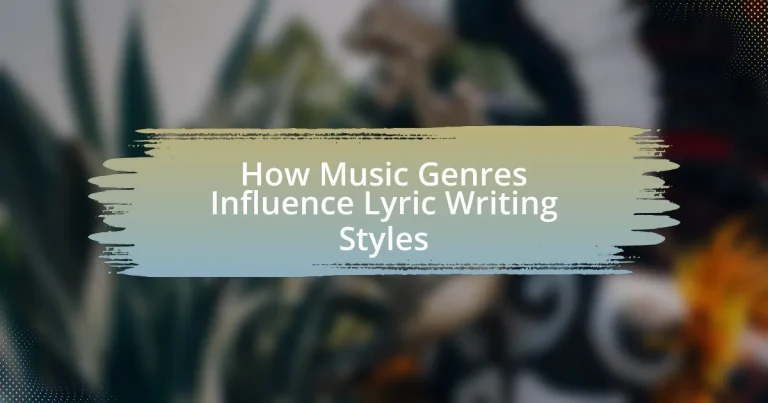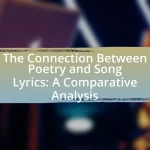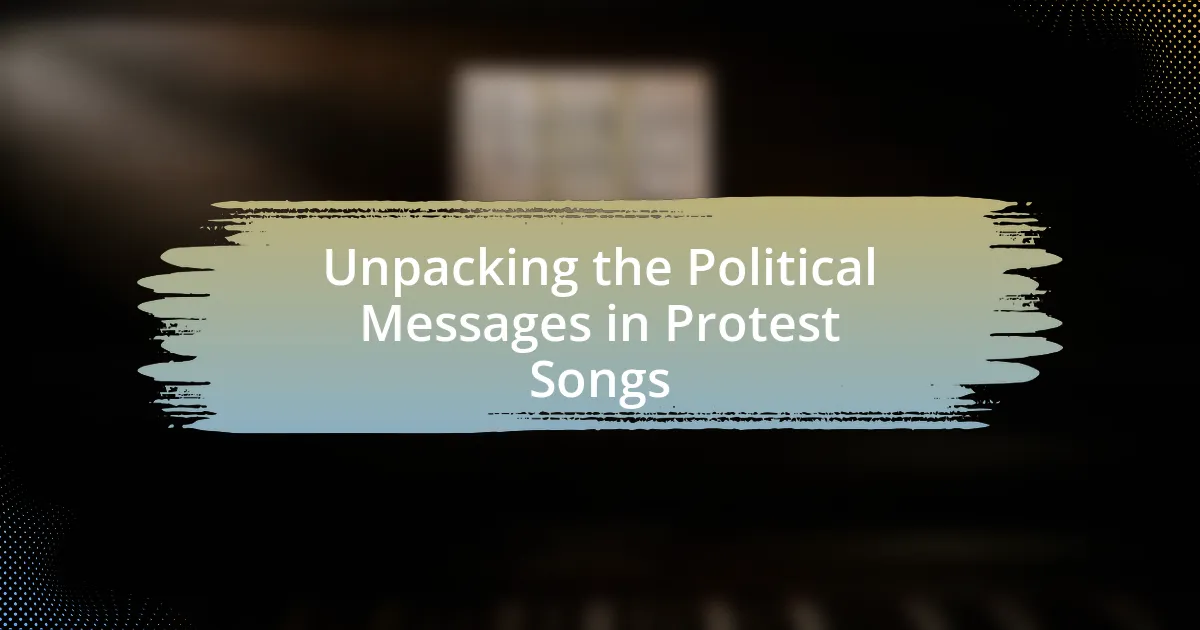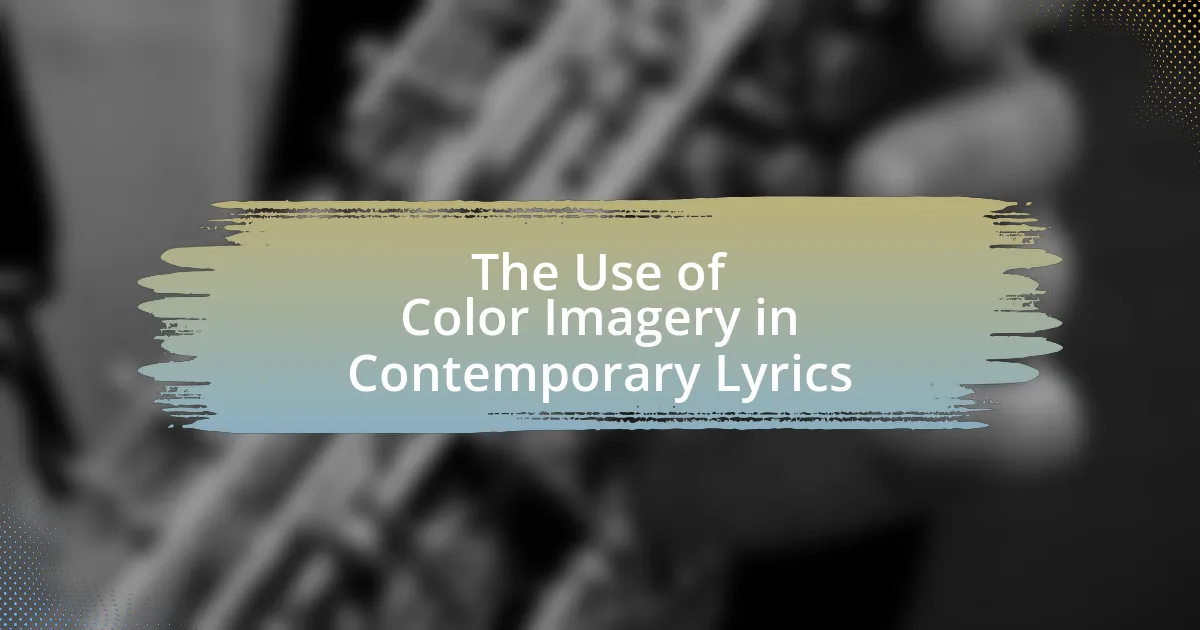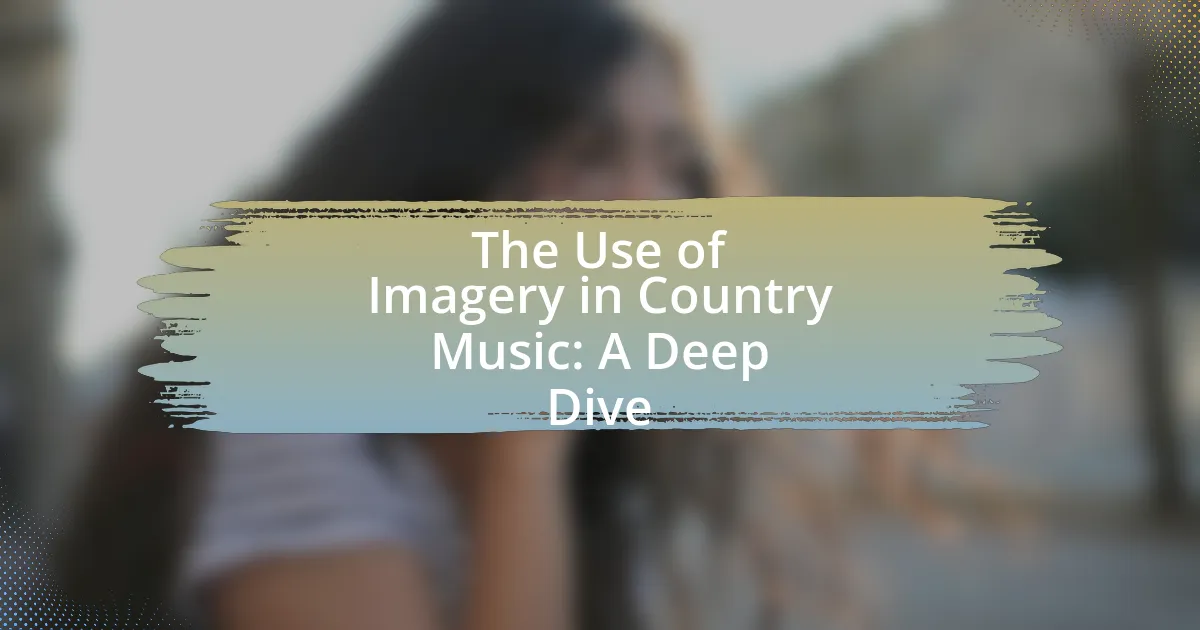The article examines how music genres influence lyric writing styles, highlighting the distinct characteristics and thematic content associated with various genres such as hip-hop, country, rock, pop, jazz, and electronic music. It discusses the impact of lyrical themes, rhythm, and genre conventions on the writing process, emphasizing the importance of understanding genre for lyricists to enhance creativity and audience connection. Additionally, the article explores techniques that lyricists can adopt from different genres and the benefits of cross-genre lyric writing, ultimately illustrating how genre fusion can lead to unique lyrical expressions and improved versatility in songwriting.
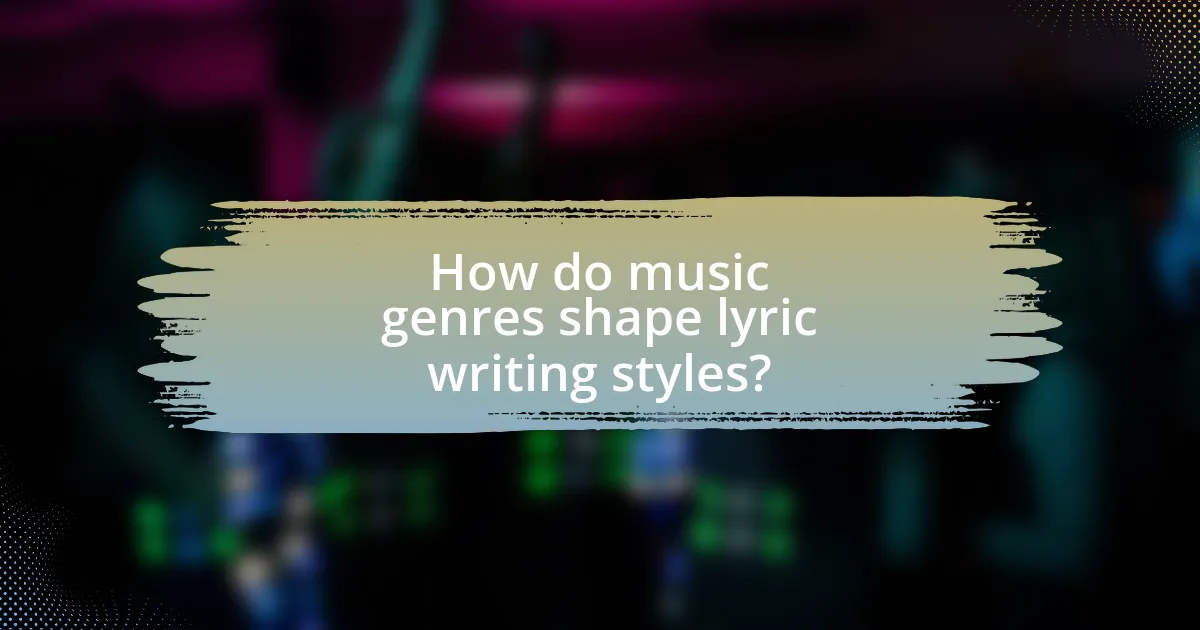
How do music genres shape lyric writing styles?
Music genres significantly shape lyric writing styles by dictating thematic content, language, and structure. For instance, hip-hop often emphasizes storytelling and personal experiences, utilizing complex rhyme schemes and wordplay, as seen in the works of artists like Nas and Kendrick Lamar. In contrast, country music typically focuses on narrative simplicity and emotional resonance, often employing straightforward language and relatable themes, as exemplified by songs from artists like Johnny Cash and Dolly Parton. Additionally, rock music frequently incorporates metaphor and abstract concepts, allowing for a more poetic approach, as demonstrated in the lyrics of bands like Pink Floyd and Led Zeppelin. These genre-specific characteristics influence how artists express their ideas and connect with their audiences, ultimately shaping the overall style of the lyrics produced within each genre.
What are the key characteristics of different music genres?
Different music genres possess distinct characteristics that influence their sound, structure, and lyrical themes. For example, rock music is characterized by strong guitar riffs, a steady backbeat, and often explores themes of rebellion and personal struggle. In contrast, hip-hop emphasizes rhythm and rhyme, featuring spoken word elements and often addressing social issues, identity, and storytelling.
Pop music is known for its catchy melodies, simple chord progressions, and themes of love and relationships, making it widely accessible. Jazz, on the other hand, is defined by its improvisational style, complex harmonies, and syncopated rhythms, often reflecting a deep emotional expression.
Country music typically features storytelling lyrics, acoustic instruments, and themes related to rural life, love, and heartache. Electronic music is characterized by synthesized sounds, repetitive beats, and often focuses on creating an immersive atmosphere rather than traditional lyrical content.
These characteristics not only define each genre but also shape the lyrical writing styles, as artists draw from the conventions and emotional landscapes of their respective genres.
How do lyrical themes vary across genres?
Lyrical themes vary significantly across music genres, reflecting the cultural, emotional, and social contexts of each genre. For instance, country music often emphasizes storytelling, personal experiences, and themes of love and heartbreak, as seen in songs by artists like Johnny Cash and Dolly Parton. In contrast, hip-hop frequently addresses social issues, identity, and resilience, with artists like Kendrick Lamar and Nas using their lyrics to comment on systemic injustices. Rock music often explores themes of rebellion, existential angst, and personal freedom, exemplified by bands like Nirvana and The Rolling Stones. Pop music tends to focus on universal themes of love, joy, and relationships, appealing to a broad audience, as demonstrated by artists like Taylor Swift and Ed Sheeran. These variations in lyrical themes across genres illustrate how different musical styles shape the content and emotional resonance of the lyrics.
What role does rhythm play in lyric writing for various genres?
Rhythm is fundamental in lyric writing across various genres as it shapes the flow and emotional impact of the lyrics. In genres like hip-hop, rhythm dictates the delivery and timing of words, enhancing the lyrical complexity and allowing for intricate rhyme schemes. For instance, artists like Eminem utilize syncopation and varied meter to create a dynamic listening experience. In contrast, in pop music, a consistent rhythmic structure often supports catchy hooks and singable melodies, exemplified by Taylor Swift’s use of straightforward rhythmic patterns that enhance memorability. Additionally, in rock music, rhythm can drive the intensity of the lyrics, as seen in the works of bands like Led Zeppelin, where the interplay between rhythm and lyrical content amplifies the song’s emotional weight. Thus, rhythm not only influences the technical aspects of lyric writing but also plays a crucial role in conveying the intended message and feeling within each genre.
Why is understanding genre important for lyricists?
Understanding genre is crucial for lyricists because it shapes their writing style, themes, and audience connection. Each genre has distinct conventions, such as lyrical structure, vocabulary, and emotional tone, which influence how lyrics are crafted. For instance, country music often tells a story with relatable themes, while hip-hop focuses on rhythm and wordplay. By understanding these nuances, lyricists can effectively communicate their message and resonate with their target audience, enhancing the overall impact of their work.
How can genre knowledge enhance a lyricist’s creativity?
Genre knowledge enhances a lyricist’s creativity by providing a framework of established themes, structures, and stylistic elements that can inspire innovative expression. Understanding the conventions of various genres, such as the storytelling techniques in country music or the rhythmic patterns in hip-hop, allows lyricists to experiment within those boundaries while also pushing them. For instance, a study by the University of Southern California found that familiarity with genre-specific tropes can lead to more original lyrical content, as artists can blend traditional elements with personal experiences to create unique narratives. This knowledge not only informs their writing process but also helps them connect with audiences who resonate with those genre-specific cues.
What impact does genre have on audience reception of lyrics?
Genre significantly impacts audience reception of lyrics by shaping expectations and emotional responses. Different genres, such as hip-hop, country, or rock, carry distinct cultural connotations and lyrical themes that resonate differently with listeners. For instance, hip-hop often emphasizes storytelling and social issues, which can engage audiences seeking authenticity and relatability, while country music frequently focuses on personal narratives and emotional experiences, appealing to listeners’ sentiments. Research indicates that genre familiarity influences how audiences interpret and connect with lyrics, as seen in a study by North and Hargreaves (2008), which found that listeners’ emotional responses varied significantly based on the genre of music being played. This demonstrates that genre not only frames the lyrical content but also dictates the emotional lens through which audiences perceive and engage with the lyrics.
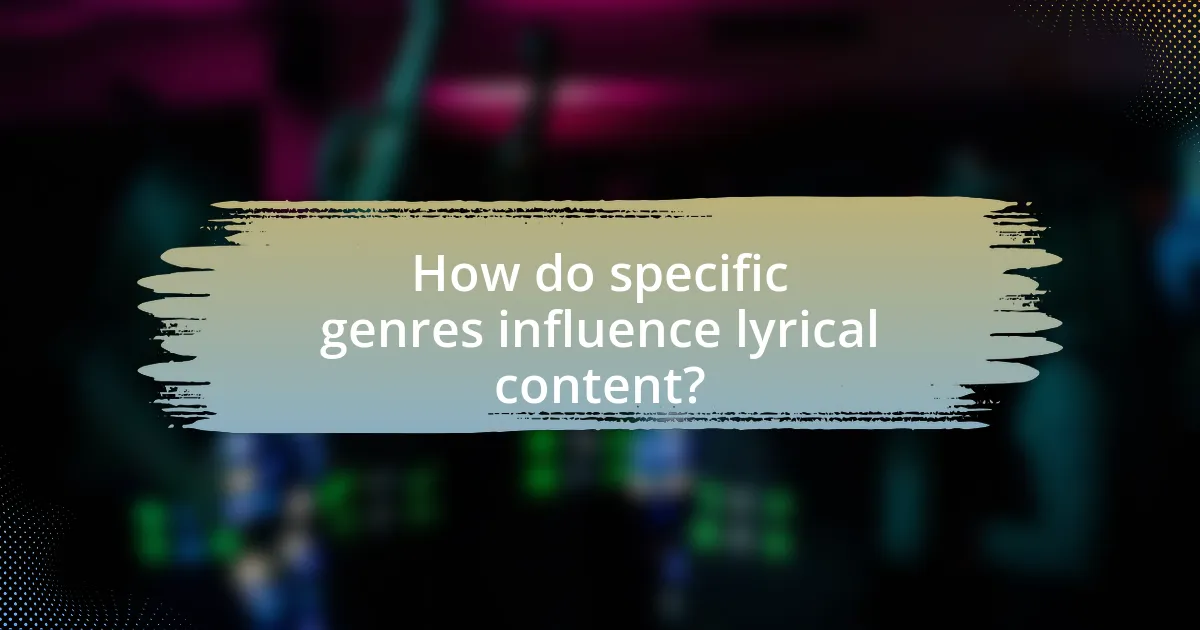
How do specific genres influence lyrical content?
Specific genres significantly influence lyrical content by dictating themes, language, and emotional expression. For instance, hip-hop often emphasizes storytelling and social commentary, reflecting cultural and political issues, as seen in artists like Kendrick Lamar, whose lyrics address systemic racism and personal struggles. In contrast, country music frequently focuses on personal narratives, love, and rural life, exemplified by songs from artists like Dolly Parton, which often highlight storytelling through relatable experiences. Additionally, rock music tends to explore themes of rebellion and existential angst, as demonstrated by bands like Nirvana, whose lyrics encapsulate feelings of disillusionment. These genre-specific characteristics shape how artists convey messages and connect with their audiences, reinforcing the idea that lyrical content is inherently tied to the conventions and expectations of each genre.
What are the lyrical conventions in pop music?
Lyrical conventions in pop music primarily include simple and relatable themes, catchy hooks, and repetitive structures. These conventions are designed to enhance memorability and emotional connection with listeners. For instance, pop lyrics often focus on universal experiences such as love, heartbreak, and celebration, making them accessible to a wide audience. Additionally, the use of verse-chorus-verse structures allows for easy sing-along moments, which is a hallmark of pop music. Research indicates that songs with repetitive hooks can increase listener engagement, as seen in studies analyzing chart-topping hits.
How do storytelling techniques differ in pop lyrics?
Storytelling techniques in pop lyrics often emphasize personal experiences and emotions, utilizing relatable themes and straightforward narratives. Unlike genres such as country or folk, which may incorporate more complex storytelling with detailed character development and plot arcs, pop lyrics typically focus on immediate feelings and catchy hooks to engage listeners quickly. For instance, a study by the University of Southern California found that pop songs often prioritize repetitive structures and simple language, making them accessible and memorable, which contrasts with the intricate storytelling found in other genres. This approach allows pop music to resonate with a broad audience, as it often reflects universal experiences like love, heartbreak, and celebration.
What common themes are found in pop lyrics?
Common themes found in pop lyrics include love, heartbreak, empowerment, and celebration. Love is often depicted through romantic relationships, highlighting emotions and experiences that resonate with listeners. Heartbreak frequently explores the pain of lost love, capturing feelings of sadness and longing. Empowerment themes focus on self-confidence and resilience, encouraging listeners to embrace their individuality. Celebration often revolves around joy, fun, and living in the moment, reflecting a carefree attitude. These themes are prevalent in numerous hit songs, demonstrating their universal appeal and relatability across diverse audiences.
How does hip-hop culture shape its lyric writing style?
Hip-hop culture shapes its lyric writing style through its emphasis on storytelling, social commentary, and rhythmic complexity. This genre often reflects the lived experiences of marginalized communities, using personal narratives to convey broader societal issues such as inequality and injustice. For instance, artists like Nas and Kendrick Lamar incorporate vivid imagery and intricate wordplay to articulate their perspectives, which resonates with listeners and fosters a deeper connection to the themes presented. Additionally, the use of slang and cultural references in hip-hop lyrics enhances authenticity and relatability, further solidifying the genre’s unique voice within the music landscape.
What is the significance of wordplay and rhyme schemes in hip-hop?
Wordplay and rhyme schemes are significant in hip-hop as they enhance lyrical complexity and artistic expression. The use of clever wordplay allows artists to convey deeper meanings, create humor, and engage listeners through intricate language. Rhyme schemes contribute to the musicality of the lyrics, making them more memorable and impactful. For instance, artists like Nas and Eminem are known for their sophisticated rhyme patterns and double entendres, which elevate their storytelling and emotional resonance. This emphasis on linguistic creativity is a hallmark of hip-hop, reflecting its roots in oral traditions and competitive lyricism.
How do social issues influence hip-hop lyrics?
Social issues significantly influence hip-hop lyrics by providing a platform for artists to express their experiences and perspectives on societal challenges. Hip-hop often addresses themes such as poverty, racism, police brutality, and inequality, reflecting the realities faced by marginalized communities. For instance, songs like “Fight the Power” by Public Enemy and “Alright” by Kendrick Lamar explicitly tackle systemic racism and social injustice, resonating with listeners who share similar struggles. This connection between social issues and hip-hop lyrics not only raises awareness but also fosters a sense of community and empowerment among listeners, illustrating the genre’s role as a voice for the voiceless.
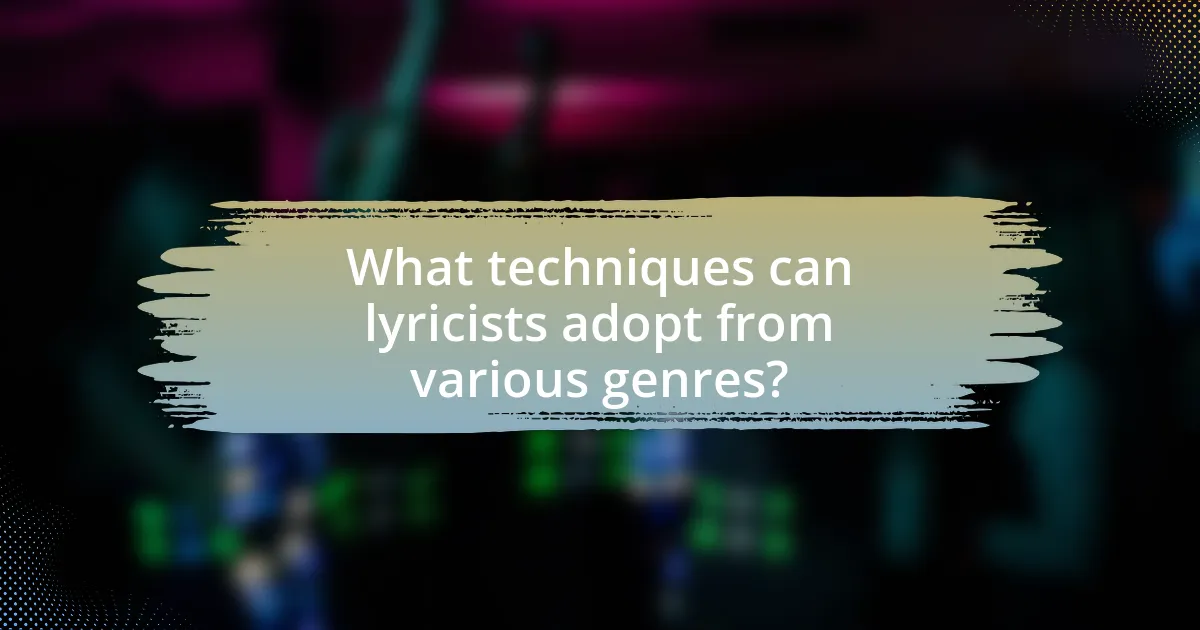
What techniques can lyricists adopt from various genres?
Lyricists can adopt techniques such as storytelling from country music, wordplay from hip-hop, and emotional imagery from pop music. Storytelling in country music often involves detailed narratives that engage listeners, as seen in songs like “The Night the Lights Went Out in Georgia” by Vicki Lawrence. Hip-hop frequently employs intricate wordplay and rhyme schemes, exemplified by artists like Eminem, who uses multisyllabic rhymes to enhance lyrical complexity. Emotional imagery in pop music, as demonstrated by Taylor Swift’s use of vivid descriptions in songs like “All Too Well,” allows lyricists to evoke strong feelings and connect with audiences. These techniques can enrich a lyricist’s writing by incorporating diverse styles and enhancing their overall lyrical expression.
How can lyricists blend styles from different genres?
Lyricists can blend styles from different genres by incorporating diverse rhythmic patterns, thematic elements, and linguistic techniques characteristic of each genre. For instance, a hip-hop lyricist might adopt the storytelling aspect of country music while using the rhythmic flow typical of rap. This fusion allows for innovative expressions and broader appeal, as seen in collaborations like Lil Nas X’s “Old Town Road,” which combines country and hip-hop elements. Such genre-blending not only enriches the lyrical content but also reflects the evolving nature of music, where cross-genre experimentation has become increasingly popular and commercially successful.
What are the benefits of cross-genre lyric writing?
Cross-genre lyric writing enhances creativity and broadens artistic expression. By blending elements from various genres, lyricists can explore diverse themes, styles, and emotional depths, leading to innovative and unique compositions. For instance, a study published in the Journal of Popular Music Studies highlights that artists who incorporate multiple genres often reach wider audiences and foster greater listener engagement, as they appeal to fans of different musical backgrounds. This versatility not only enriches the lyrical content but also encourages collaboration among artists, further expanding the creative possibilities in music.
How can genre fusion create unique lyrical expressions?
Genre fusion creates unique lyrical expressions by blending diverse musical styles, which allows artists to explore varied themes and perspectives. This combination often results in innovative storytelling techniques and emotional depth, as seen in genres like hip-hop and country, where artists like Lil Nas X have successfully merged elements to convey complex narratives. The interplay of different lyrical traditions enriches the vocabulary and imagery available to songwriters, enabling them to craft more nuanced and relatable lyrics. For instance, the fusion of reggae and rock in the works of bands like The Police has led to lyrics that resonate across cultural boundaries, demonstrating how genre fusion can expand the expressive potential of songwriting.
What best practices should lyricists follow when exploring genres?
Lyricists should immerse themselves in the specific characteristics and themes of each genre they explore. Understanding the unique elements, such as lyrical structure, common motifs, and emotional tone, is crucial for effective genre adaptation. For instance, country music often emphasizes storytelling and personal experiences, while hip-hop frequently incorporates rhythm and wordplay. By analyzing successful songs within a genre, lyricists can identify patterns and techniques that resonate with audiences. Research indicates that familiarity with genre conventions enhances a lyricist’s ability to craft authentic and engaging lyrics, as seen in the diverse styles of artists like Taylor Swift and Kendrick Lamar, who successfully navigate multiple genres while maintaining their unique voices.
How can studying different genres improve lyrical versatility?
Studying different genres can significantly improve lyrical versatility by exposing writers to diverse themes, structures, and stylistic devices. Each genre, such as hip-hop, country, or rock, employs unique storytelling techniques and emotional expressions, allowing lyricists to expand their creative toolkit. For instance, hip-hop often emphasizes rhythm and wordplay, while country music focuses on narrative and imagery. This exposure enables lyricists to blend elements from various genres, enhancing their ability to craft innovative and engaging lyrics. Research indicates that musicians who explore multiple genres develop a broader understanding of musical language, which can lead to more original and impactful songwriting.
What resources are available for lyricists to learn about genre influences?
Lyricists can utilize various resources to learn about genre influences, including books, online courses, and music analysis platforms. Books such as “Writing Better Lyrics” by Pat Pattison provide foundational knowledge on lyric writing across genres. Online platforms like Coursera and MasterClass offer courses specifically focused on songwriting and genre exploration, featuring insights from established artists. Additionally, music analysis websites like Genius provide annotations and breakdowns of lyrics, allowing lyricists to understand how different genres shape lyrical themes and structures. These resources collectively enhance a lyricist’s understanding of genre influences in their writing.
